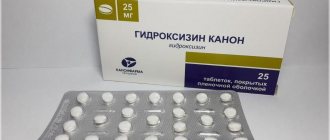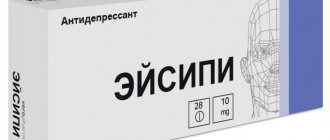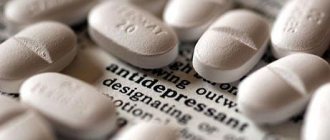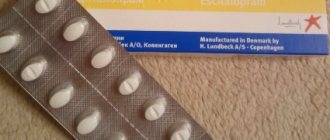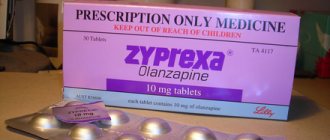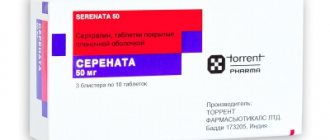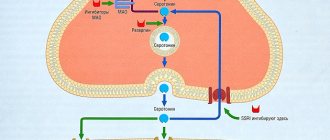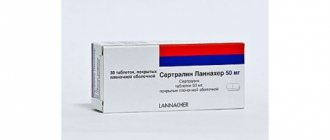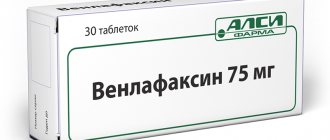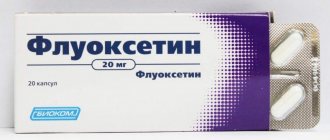The most optimal class of antidepressants (ADs) in recent years in terms of the ratio of side effects and effectiveness are selective serotonin reuptake inhibitors (SSRIs). Selectivity means selectivity of action when the active substance of a drug is able to act on a specific side in the complex mechanism of neurotransmitters, without suppressing or stimulating the production of others. The result is better tolerability and safety compared to older ADs.
All antidepressants of the SSRI group have a more or less similar mechanism of action, but they differ from each other both structurally and pharmacologically. These differences determine drug interactions with other drugs, duration of action, clinical effectiveness, and the risk of side effects.
The following medications are used only as prescribed by a doctor.
The list of SSRIs includes the top 5 most common:
- paroxetine (Paxil, Rexetine, Plisil);
- sertraline (Zoloft, Stimuloton, Asentra).
- escitalopram (Cipralex, Elitseya, Lenuxin);
- fluoxetine (Prozac and many generics);
- citalopram (Cipramil);
The five of these ADs are not presented in order of appearance. The first SSRI drug was fluoxetine, released in the USA under the brand name Prozac in 1987, the second was sertraline (brand Zoloft). After them, paroxetine (Paxil) went on sale 2 years later. Five years later, citalopram was approved, and in the early 2000s, its modified and improved version, escitalopram.
How do SSRI antidepressants work?
In the brain, signals between nerve cells (neurons) are transmitted using special chemicals called neurotransmitters or neurotransmitters: serotonin, dopamine, norepinephrine, glutamate and others. During experiments, scientists found that changes or disturbances in the functioning of neurotransmitters can affect behavior and mood. Although low levels of serotonin and norepinephrine do not cause depression, increased levels of these chemicals are associated with improved mood in people suffering from depression.
SSRIs relieve symptoms of depression by blocking the reabsorption (re-uptake) of serotonin by nerve cells in the brain. The remaining available serotonin increases neurotransmission and improves mood. SSRIs are called selective because they affect serotonin much more strongly than other neurotransmitters. Over time, natural serotonin levels will rise again and the dose may be reduced or discontinued.
SSRI drugs relieve symptoms of depression by slowing down or completely blocking the re-uptake of serotonin by nerve cells, which is why they are called inhibitors, i.e. reuptake inhibitors. And they are called selective for their ability to influence predominantly serotonin (up to 10 times more selectively), without affecting other mediators.
Contraindications
Manic states, hypersensitivity to the drug, concomitant treatment with MAO inhibitors[2], epilepsy and latent paroxysmal activity, age less than 15 years, pregnancy, breastfeeding[3] (breastfeeding is stopped during the treatment period).
In case of severe renal failure and liver diseases, citalopram can only be used in reduced doses[4]. Avoid use in patients at increased risk of gastrointestinal bleeding while taking SSRIs (older age or history of gastrointestinal bleeding)[5].
SSRIs cannot be used for poisoning with alcohol, psychotropic drugs and other drugs[6].
Difference in readings
Each SSRI drug has a unique profile of pharmacological effects that distinguishes it in effectiveness and tolerability from its classmates. The main indication for use is depression, for the treatment of which ADs are first-line drugs, but there are also a number of other disorders for which antidepressants are prescribed. For each of the five drugs listed above, let’s look at the mental illnesses that they deal with most effectively.
Citalopram and Escitalopram
- Major depressive disorder
- Generalized anxiety (panic) disorder
Paroxetine
- Major depressive disorder (MDD)
- Obsessive-compulsive disorder (OCD)
- Panic disorder
- Anxious personality disorder
- Generalized anxiety (panic) disorder
- Post-traumatic stress disorder
Fluoxetine
- Major depressive disorder
- Obsessive-compulsive disorder (OCD)
- Moderate to severe bulimia nervosa
- Panic disorder
Sertraline
Zoloft – 28 tablets
- Major depressive disorder (MDD)
- Obsessive-compulsive disorder
- Panic disorder
- Post-traumatic stress disorder
- Premenstrual dysphoric disorder (PMDD)
- Anxious personality disorder
Escitalopram analogues
There are a number of drugs with the common active substance escitalopram. Such drugs are often called analogues, in medical terminology - synonyms, which differ in name and manufacturer. These include: selectra (Malta, Germany, Iceland), lenuxin (Poland, Hungary), miracitol (Turkey), sancipam (India), esipi (Russia, India), cipralex (Denmark), escitalopram Sandoz (Slovenia), escitalopram Teva (Israel), escitalopram canon (Russia).
Difference in Efficiency
Comparative clinical studies of representatives of the group of selective serotonin reuptake inhibitors show that drugs of this class reliably work. Each antidepressant reduces the severity of symptoms by at least half. However, there are some differences in effectiveness.
Escitalopram may provide more consistent results than other SSRIs in the treatment of major depressive disorder (1) and better efficacy than citalopram in the treatment of major depression.
Paroxetine is the only SSRI that can be prescribed for five types of anxiety disorders in addition to MDD.
Fluoxetine may exhibit antidepressant effects more slowly than other SSRIs.
Paroxetine, fluoxetine, and sertraline are similar in their effectiveness in treating MDD and depression with high anxiety levels (2).
Sertraline has advantages over paroxetine in the treatment of panic disorder (3).
Reviews from doctors
Experts emphasize that the success of treatment depends not only on the effect of the drug, but also on the patient’s mood. Being prepared for long-term treatment is one of the components of recovery. Taking escitalopram provides reliable support for the nervous system and quickly improves well-being, but it takes time to consolidate the results.
The drug rarely causes obvious side effects and is well tolerated by patients. Its dose must be carefully selected and adjusted during treatment according to the patient’s condition.
If it is not possible to purchase escitalopram, doctors recommend drugs with an identical composition that have the same effect, but at a more affordable price.
Currently, escitalopram and its synonyms are considered the most popular drugs in their category. The new mechanism of action in a short time begins to change the patient’s condition for the better.
Comparison of side effects
SSRI antidepressants may cause a list of the following adverse effects:
- nausea;
- erectile dysfunction in men, including decreased libido;
- diarrhea;
- headache;
- nervousness;
- insomnia;
- agitation (excitement) and anxiety;
- sweating;
- dry mouth;
- tachycardia (increased heart rate);
- anorexia or, conversely, increased appetite;
- weight gain;
- insomnia or vice versa drowsiness.
The most common side effect associated with SSRI use is nausea. Paroxetine and sertraline are slightly more likely to cause nausea.
Sexual dysfunction, including anorgasmia, decreased libido, impotence and delayed ejaculation.
Analysis of clinical trials shows that fluoxetine is less likely to cause such effects than paroxetine and sertraline. Paroxetine or citalopram are generally the most likely to cause sexual weakness until drug discontinuation (4). Frequency of cases of depression of sexual function during use
| A drug | Percentage of cases |
| Citalopram | 72,7% |
| Paroxetine | 70,7% |
| Sertraline | 69,2% |
| Fluoxetine | 57,7% |
Weight gain is also a common side effect of antidepressants, especially if there are genetic (family) predisposing factors. SSRIs vary in their effect on a patient's weight. Fluoxetine and sertraline are less likely to cause weight gain during long-term treatment than paroxetine and citalopram (5). Paroxetine can cause significant weight gain and is more likely to cause this side effect than other SSRIs. Fluoxetine, on the other hand, suppresses appetite and may promote modest weight loss.
Fluoxetine, paroxetine and sertraline are the most common causes of insomnia or poor sleep quality. All three of these ADs delay the onset of REM sleep, and fluoxetine and paroxetine further increase the frequency of awakenings and reduce REM and non-REM sleep, its total duration and efficiency. Sertraline, on the contrary, slightly increases sleep efficiency and reduces the time of night wakefulness, and may be appropriate for depressed patients with sleep disorders.
Anxiety, agitation and agitation are most often provoked by fluoxetine, but patterns that allow this to be predicted before prescribing the drug have not been identified. Patients with anxiety and agitation may also tolerate it well, although this is less likely to occur than with other SSRIs.
Pharmacokinetics
When taken orally, Cmax is determined after 2-4 hours. Bioavailability is 80%, binding to plasma proteins is less than 80%. Changes in plasma concentrations are linear. After 1-2 weeks of therapy, an equilibrium concentration is established in the plasma. In blood plasma, citalopram is present mainly unchanged. Metabolized by demethylation, deamination and oxidation. T
1/2 is 1.5 days. Excreted by the kidneys and through the intestines. The antidepressant effect develops after 2-4 weeks of treatment.
Which SSRI is the best?
There is no ideal antidepressant, and even in the same doses and for the same disorders, the effectiveness and tolerability will vary for each person. Therefore, at the beginning of treatment, the doctor can change the blood pressure itself several times, its dosage, and combine it with other drugs to correct side effects.
According to a large analysis of the effects of antidepressants published in the scientific journal Lancet (6), SSRI drugs can be roughly divided into individual qualities of therapeutic action.
The fastest
Escitalopram has the most rapid antidepressant effect and may be the drug of choice when a rapid response is needed, while fluoxetine has the slowest antidepressant effect (see table below).
Most soothing
Paroxetine has the most pronounced sedative effect among the above-mentioned SSRIs.
Most stimulating
Fluoxetine and sertraline are more active and are preferred in depressed patients with apathy, lack of energy or drowsiness. Accordingly, they are least preferable for people with anxiety and insomnia.
The drug Stimuloton based on sertraline (50 mg)
The most anti-anxiety
Escitalopram has a strong anxiolytic effect.
Which SSRI is best tolerated?
Escitalopram and sertraline appear to be the most well-tolerated antidepressants in patients who are compliant with their dosage regimen.
For those who tend to skip doses or interrupt treatment - fluoxetine. Comparison table of SSRI drugs
| Property | Fluoxetine | Sertraline | Paroxetine | Citalopram | Escitalopram |
| Average daily dosage for the treatment of MDD | 10-20 mg | 50-100 mg | 20 mg | 20-40 mg | 10-20 mg |
| Average time to sustained therapeutic effect | from 1 to 2 months | from 1 to 2 weeks | from 10 days to 2 weeks | from a week | |
| Most common side effects | nausea, insomnia, nervousness, anxiety, headache, drowsiness, loss of appetite, diarrhea | nausea, headache, sexual dysfunction (impaired ejaculation, decreased libido), drowsiness, dizziness, insomnia, diarrhea, dry mouth, fatigue | nausea, drowsiness, headache, dry mouth, fatigue, sexual dysfunction, increased sweating, dizziness, weakness, diarrhea, insomnia | nausea, dry mouth, drowsiness, insomnia, increased sweating, diarrhea | nausea, insomnia, diarrhea, headache |
| Number of unwanted interactions with other medications | high | relatively low | medium-high | relatively low | |
Escitalopram reviews
Patients taking the drug characterize it differently, but the vast majority of reviews are positive. Thus, patients note the disappearance of insomnia, nervousness, feelings of fear and anxiety. My mood is gradually returning to normal. Escitalopram is not addictive, there were few or no side effects.
As for negative reviews, they are based on impatience or disbelief in the result. Thus, some patients consider the presence of adverse reactions of the drug in the first 10-14 days to be a disadvantage: anxiety, pressure imbalance, dizziness, drowsiness, constant feeling of hunger. These same people talk about stabilization of the condition in the end, but additional disadvantages include the high price of the drug per course.
Composition and pharmaceutical form of the drug
The antidepressant is available in tablet form containing escitalopram 5 mg, 10 mg or 20 mg.
- Structure-forming ingredients: CMC, aerosil, primelose, stearic acid, E 572.
- Coating: Opadry white Y-l7000H.
The pharmaceutical form of all drugs is round tablets with convex surfaces, coated in white with cling film. They are distinguished by different markings:
- Drug 5 mg: marking on one surface 93, on the opposite - 7414
- Drug 10 mg: on one surface there is a break line, on both sides of which there is an engraving of 9 and 3, on the opposite side there is the number 7462
- Drug 20 mg: on both sides of the dividing strip - numbers 9 and 3, on the reverse - 7463.
The pills are packaged in blisters of 10, 14 or 28 pieces. The pack contains 1, 2, 4 tablets with a description of use.
Mutual drug reactions
During treatment with Escitalopram, unwanted combinations with certain drugs should be avoided:
Contraindicated combinations include:
- Combination with any drugs that can prolong the QT interval, since they have not been studied and the consequences are unknown. Combination with antiarrhythmic drugs, antipsychotics, TCAs, some antibiotics and antihistamines should be avoided.
- When taken together with MAOIs, the development of serotonin syndrome is expected. To prevent its occurrence, Escitalopram should be stopped 2 weeks before taking MAO inhibitors and resumed after their completion after the same amount of time.
Combinations of drugs that require caution:
- Simultaneous use with serotonergic drugs (tramadol, sumatriptan, oxytriptan, etc.) can provoke serotonin intoxication.
- Combination with drugs that reduce the level of seizure activity (tricyclines, other SSRIs, antipsychotics, mefloquine, tramadol).
- The effect of Escitalopram is enhanced when combined with products containing lithium, as well as tryptophan.
- Combination with drugs with St. John's wort increases the risk and intensity of side effects.
- The risk of bleeding increases if Escitalopram is used simultaneously with NSAIDs, ASA, anticoagulants, TCAs, atypical antipsychotics and drugs that change platelet counts.
- Combination with ethyl alcohol is extremely undesirable. During therapy you should avoid alcohol and ethanol-containing drugs.
- When combined with drugs that promote abnormally low potassium and magnesium levels, the threat of life-threatening arrhythmias increases.
- During therapy with Escitalopram, it must be taken into account that its metabolism is carried out with the participation of P450 isoenzymes. Therefore, caution should be exercised if drugs with a similar metabolic mechanism or its inhibitor are used simultaneously. Otherwise, this will lead to distortion of therapeutic actions. If it is not possible to avoid such combinations, then you need to be especially careful when determining dosages.
Escitalopram price, where to buy
The price of Escitalopram in pharmacies for 28 pieces is from 300 rubles.
- Online pharmacies in RussiaRussia
- Online pharmacies in UkraineUkraine
ZdravCity
- Escitalopram tab.
p.p.o. 10 mg 30 pcs. Pranapharm LLC 227 rub. order - Escitalopram tablets p.p.o. 10 mg 28 pcs. Berezovsky Pharm. z-d JSC
RUB 227 order
Pharmacy Dialogue
- Escitalopram (tab. ppl/vol. 10 mg No. 28) Berezovsky plant
RUB 248 order
show more
Pharmacy24
- Escitalopram Teva 20 mg N28 tablets TOV Teva Operations Poland, Poland
275 UAH order - Escitalopram Teva 10 mg No. 28 tablets TOV Teva Operations Poland, Poland
170 UAH order

